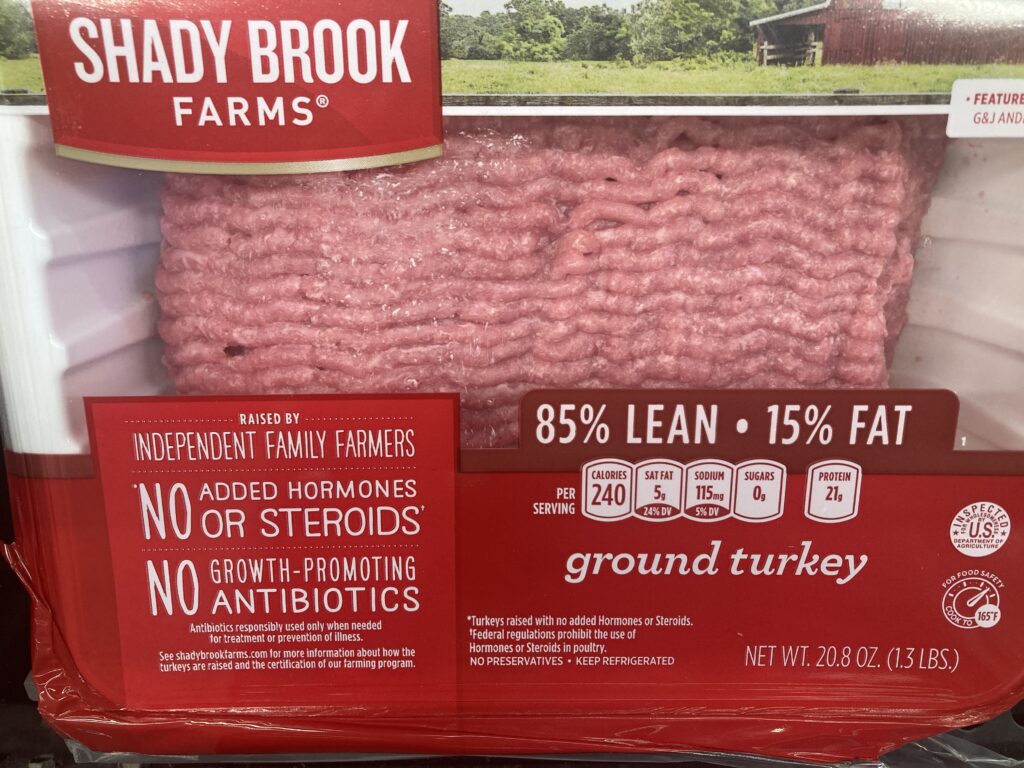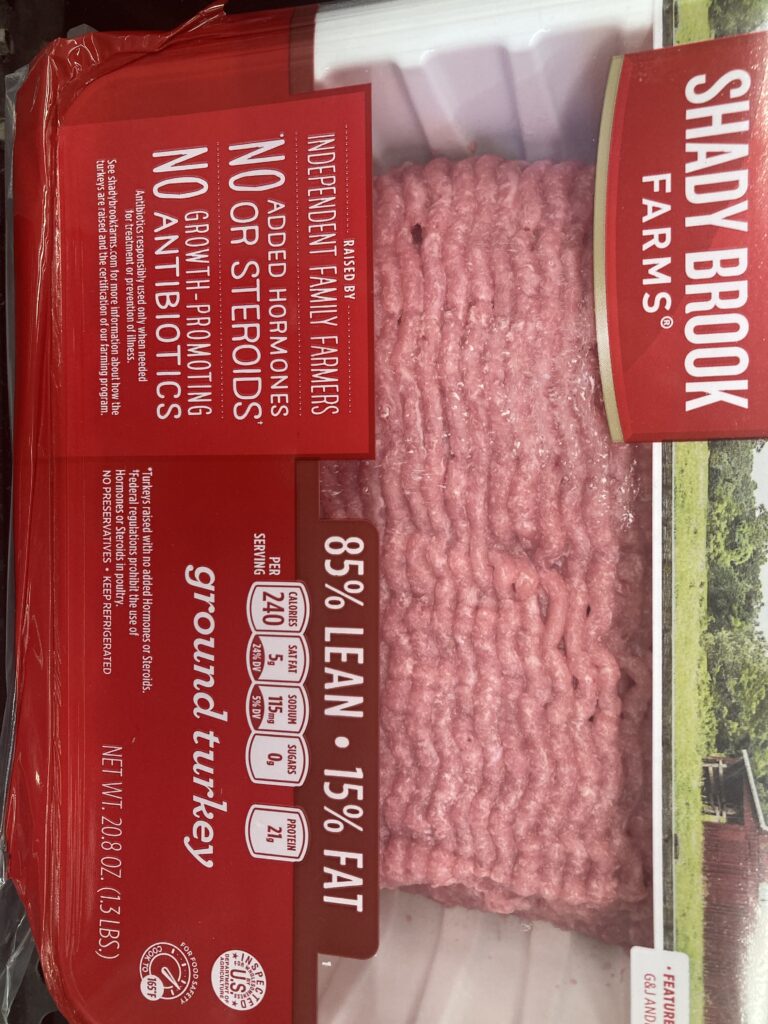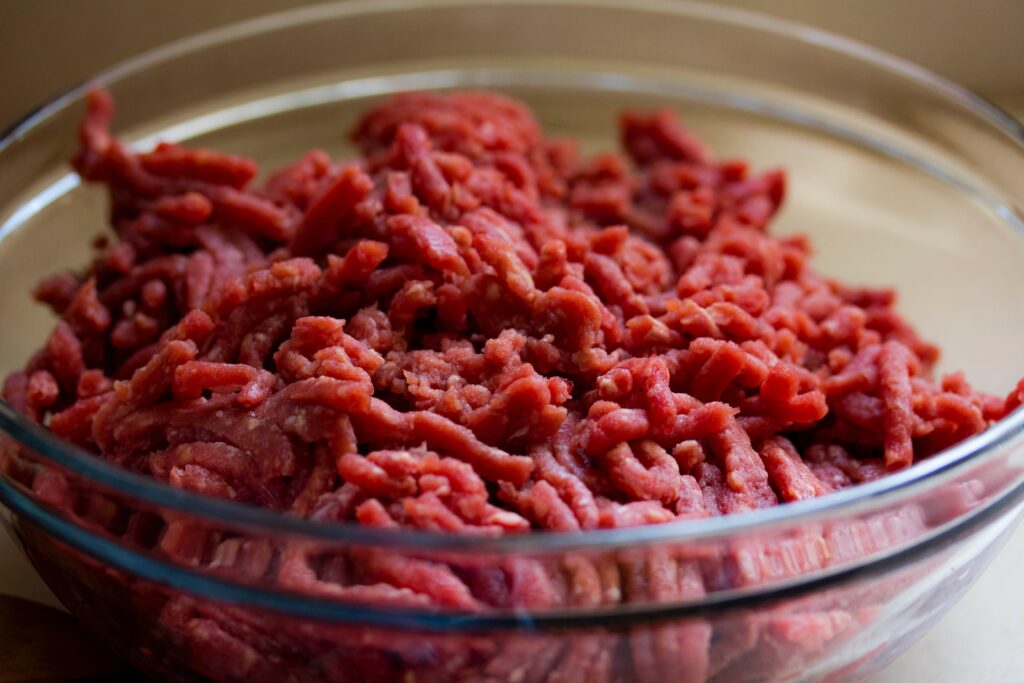Ground turkey Coarser and firmer, high protein, Slightly higher in calories, rich in B vitamins, iron, and zinc, remain moist longer.. Ground Chicken Breast finer and softer, lower calories Rich in B vitamins and minerals like phosphorus and selenium, can dry out if overcooked.
Turkey and chicken breast ground meats are versatile in the kitchen, suitable for grilling, baking, sautéing, or using in various recipes like burgers, meatballs, and casseroles.
They offer a healthy and flavorful option for those seeking a nutritious protein source.
Ground Turkey vs. Ground Chicken Breast: Nutrition Facts and Health Tips

Ground turkey is typically made from turkey meat and is known for being lower in fat compared to ground beef, making it a healthier option for those looking to reduce their fat intake.
Turkey and chicken breast ground are both excellent sources of lean protein, each with their own unique qualities and benefits.

Turkey ground meat is derived from turkey and is known for its slightly leaner profile compared to ground chicken.
Due to its lower fat content, it’s a popular choice for those looking to reduce their overall fat intake while still enjoying a protein-rich diet.
| Nutrient | Amount per Serving (4 oz / 112g) |
|---|---|
| Calories | 170 |
| Total Fat | 9 g |
| Saturated Fat | 2.5 g |
| Trans Fat | 0 g |
| Cholesterol | 80 mg |
| Sodium | 90 mg |
| Total Carbohydrates | 0 g |
| Dietary Fiber | 0 g |
| Sugars | 0 g |
| Protein | 22 g |
| Vitamin A | 0% DV |
| Vitamin C | 0% DV |
| Calcium | 2% DV |
| Iron | 6% DV |
Chicken breast ground meat, on the other hand, is made from the leanest part of the chicken and is renowned for being extremely low in fat. It is one of the leanest protein options available, making it an excellent choice for individuals looking to build or maintain muscle mass.
Additionally, it’s a great source of essential nutrients such as B vitamins, particularly niacin and B6.
| Nutrient | Amount per Serving (4 oz / 112g) |
|---|---|
| Calories | 120 |
| Total Fat | 3 g |
| Saturated Fat | 1 g |
| Trans Fat | 0 g |
| Cholesterol | 80 mg |
| Sodium | 75 mg |
| Total Carbohydrates | 0 g |
| Dietary Fiber | 0 g |
| Sugars | 0 g |
| Protein | 22 g |
| Vitamin A | 0% DV |
| Vitamin C | 0% DV |
| Calcium | 2% DV |
| Iron | 6% DV |
| Niacin (Vitamin B3) | 50% DV |
| Vitamin B6 | 30% DV |
Protein Quality and Muscle Gain :How turkey vs chicken contribute
The quality of protein is determined by its amino acid profile and digestibility. Complete proteins, which contain all nine essential amino acids, are considered high-quality proteins. These are vital for muscle repair and growth. Some factors influencing protein quality include:
- Amino Acid Composition: Proteins that contain all essential amino acids in the right proportions are optimal for muscle protein synthesis.
- Digestibility: How well the protein is absorbed and utilized by the body.
Protein in Turkey vs. Chicken
Both turkey and chicken are excellent sources of high-quality protein, but there are some differences:
- Turkey:
- Generally higher in protein per serving.
- Contains more selenium, a mineral important for muscle health and metabolism.
- Slightly lower in fat, particularly saturated fat.
- Chicken:
- More widely available and often cheaper.
- Higher in niacin (Vitamin B3), which helps convert food into energy.
- Lean cuts like chicken breast are particularly high in protein and low in fat.
High-Protein Diets and Muscle Gain
High-protein diets are essential for muscle gain as they provide the amino acids necessary for muscle repair and growth. Research shows that athletes may benefit from consuming 1.2 to 2.0 grams of protein per kilogram of body weight per day. This intake helps to maximize muscle protein synthesis, especially when distributed evenly across meals throughout the day (pascal-francis.inist) (Ingenta Connect).
Choosing Between Ground Turkey and Ground Chicken Breast for Better Health
When considering which ground meat to incorporate into your diet for optimal health, it’s essential to understand the nutritional differences and benefits of ground turkey and ground chicken breast. Both are excellent sources of lean protein, but they offer distinct nutritional profiles and health benefits.
1. Protein Content
- Ground Turkey: High in protein, supporting muscle growth and repair.
- Ground Chicken Breast: Equally high in protein, aiding in muscle maintenance and recovery.
2. Fat Content
- Ground Turkey: Fat content can vary; lean ground turkey is lower in fat compared to regular ground turkey.
- Ground Chicken Breast: Generally lower in fat, especially if skinless, making it an excellent choice for a low-fat diet.
3. Calories
- Ground Turkey: Generally lower in calories than ground beef, particularly when using lean varieties.
- Ground Chicken Breast: Low-calorie option, ideal for weight management and calorie-conscious diets.
4. Cholesterol
- Ground Turkey: Lower in cholesterol compared to ground beef but can vary with fat content.
- Ground Chicken Breast: Slightly higher in cholesterol than ground turkey but still lower than red meats.
5. Nutritional Benefits
- Ground Turkey: Rich in B vitamins (B6, B12) and minerals like zinc and selenium, essential for energy production and immune function.
- Ground Chicken Breast: Excellent source of lean protein, low in saturated fat, and provides important nutrients like niacin and phosphorus.
6. Heart Health
- Ground Turkey: Opt for lean or extra-lean varieties to minimize saturated fat intake, benefiting heart health.
- Ground Chicken Breast: Its low-fat content makes it a heart-healthy choice, particularly when skinless.
7. Weight Management
- Ground Turkey: Lower calorie content can support weight loss or maintenance when using lean options.
- Ground Chicken Breast: Even lower in calories and fat, making it a prime choice for those focused on weight control.
8. Versatility in Cooking
- Ground Turkey: Slightly richer flavor and can be juicier, suitable for a variety of dishes like burgers, meatballs, and casseroles.
- Ground Chicken Breast: Milder and leaner, perfect for lighter dishes like stir-fries, salads, and wraps.
9. Digestibility
- Ground Turkey: Generally easy to digest, making it suitable for those with sensitive stomachs.
- Ground Chicken Breast: Equally digestible and a good option for people with dietary restrictions or digestive issues.
10. Environmental Impact
- Both ground turkey and ground chicken breast have a lower environmental impact compared to red meats, supporting a more sustainable diet.
Incorporating either ground turkey or ground chicken breast into a balanced diet can provide diverse nutritional benefits, aiding in muscle maintenance, weight management, and overall health.
Your choice can depend on specific dietary goals, personal taste preferences, and nutritional needs. Opt for lean or extra-lean varieties to maximize health benefits and minimize unwanted fats.
Appearances of ground turkey meat vs ground chicken breast meat
Ground turkey meat and ground chicken breast have some similarities in appearance, but there are also distinct differences:
- Color:
- Ground Turkey meat is typically a light pinkish-gray color. It may have a slightly darker hue than ground chicken.
- Ground Chicken Breast is usually lighter in color, often appearing pale pink or light beige. It tends to be lighter than ground turkey.


- Texture:
- Ground Turkey meat tends to be slightly coarser in texture compared to ground chicken breast. It may have a grainier feel.
- Ground Chicken Breast is often finer and smoother in texture. It has a softer feel due to the lean nature of chicken breast meat.
- Fat Content:
- Ground Turkey can vary in fat content depending on whether it’s made from lean turkey breast or a mix that includes dark meat. Some ground turkey can be quite lean, while others may have a higher fat content.
- Ground Chicken Breast is inherently leaner than ground turkey. It is made exclusively from the breast meat, which is one of the leanest parts of the chicken.
- Appearance of Fat:
- Ground Turkey: If the ground turkey includes dark meat, it may have slightly darker specks or streaks due to the higher fat content in the dark meat.
- Ground Chicken Breast: Since it’s made exclusively from chicken breast, there is very little visible fat content, resulting in a leaner appearance.
- Cooked Appearance:
- Ground Turkey: After cooking, ground turkey tends to take on a brownish-gray color, which is similar to cooked ground beef.
- Ground Chicken Breast: Cooked ground chicken breast remains light in color, often closer to white or a very light tan.
- Moisture Content:
- Ground Turkey: Depending on the fat content, ground turkey can range from quite moist to relatively dry after cooking.
- Ground Chicken Breast: Due to its lean nature, ground chicken breast can be drier compared to ground turkey, especially if overcooked.
Remember, the appearance can also vary based on factors like processing methods, brand, and specific cuts of meat used. It’s always a good idea to check the packaging for any specific details on fat content and processing.
Ground Turkey compare to Ground Chicken Breast
Ground Turkey
Fat Content:
- Ground Turkey is generally lower in fat compared to ground chicken breast, especially if you choose the leaner varieties, such as ground turkey breast. It can be as low as 2% fat.
Protein Content:
- Ground Turkey is a good source of lean protein, making it a suitable choice for those looking to increase their protein intake while keeping fat intake in check.
Caloric Content:
- Both ground turkey and ground chicken breast are relatively low in calories, especially when compared to higher-fat ground meats like beef or pork.
Texture and Flavor:
- Ground Turkey: It has a mild flavor and a slightly different texture compared to ground beef. It can easily take on the flavors of various seasonings and spices.
Cooking Applications:
- Ground Turkey: It can be used in a wide range of recipes, from burgers and meatballs to chili and stir-fries. It’s versatile and can adapt well to different flavor profiles.
Nutritional Profile:
- Ground Turkey: It’s a good source of essential nutrients like niacin, selenium, and phosphorus. It’s also lower in saturated fat compared to fattier meats.
Availability:
- Both ground turkey and ground chicken breast are widely available in most grocery stores, making them convenient choices for many households.
Sustainability:
- Both ground turkey and ground chicken are considered to have a lower environmental impact compared to beef, as poultry farming typically requires fewer resources like land, water and feed.
Ground Chicken breast
Fat Content:
Ground Chicken Breast: While still relatively lean, ground chicken breast may have slightly higher fat content compared to the leanest ground turkey options.
Protein Content:
Ground Chicken Breast ,Like ground turkey, ground chicken breast is also a good source of lean protein.
Caloric Content:
Both ground chicken breast and ground turkey are relatively low in calories.
Texture:
- Lean and Fine: Ground chicken breast is typically very lean, as it’s made from the breast meat which contains the least amount of fat in a chicken. This means it has a finer texture compared to ground meat from other parts of the chicken.
- Smooth and Tender: It tends to be smoother and more tender compared to ground meats with higher fat content. It doesn’t have the same marbling or coarser texture that you might find in ground beef or pork.
- Moisture Content: While chicken breast is naturally lean, it can still hold a good amount of moisture when properly cooked. This can contribute to a juicy texture.
Flavor:
- Mild and Subtle: Chicken breast itself has a relatively mild and subtle flavor compared to other cuts like thighs or drumsticks. It’s a blank canvas that can take on the flavors of seasonings, marinades, and sauces it’s cooked with.
- Slightly Sweet: Some people detect a slight natural sweetness in chicken breast, which can be more pronounced when it’s freshly cooked.
- Versatile: Its mild flavor makes it incredibly versatile. It can be used in a wide range of dishes, from stir-fries and tacos to burgers and meatballs, taking on the flavors of the ingredients it’s combined with.
Cooking ground Turkey and ground chicken
Ground Turkey:

Flavor:
- Mild and Slightly Gamey: Turkey has a mild, slightly gamey flavor compared to chicken. It’s often described as a bit richer or earthier than chicken.
- Versatile: Like chicken, ground turkey is versatile and can take on a variety of flavors. It pairs well with both savory and sweet seasonings.
- Lean but Moist: Ground turkey is typically lean, similar to chicken breast. However, it tends to be slightly moister than ground chicken breast, which can be attributed to the natural moisture content in turkey meat.
- Tender: When cooked properly, ground turkey can be very tender and juicy.
- Binder May Be Needed: Due to its lean nature, ground turkey can benefit from the addition of a binder (such as breadcrumbs or egg) to help hold it together in dishes like meatballs or burgers.
- Cook Thoroughly: It’s important to ensure that ground turkey is cooked thoroughly to a safe internal temperature to avoid any risk of foodborne illness.
Taste and flavor of Ground Chicken breast
- Mild and Subtle: Chicken breast has a mild and subtle flavor compared to other cuts of chicken. It’s often described as a blank canvas, meaning it takes on the flavors of the ingredients it’s cooked with.
- Slightly Sweet: Some people detect a slight natural sweetness in chicken breast, which can be more pronounced when it’s freshly cooked.
- Very Lean and Fine: Ground chicken breast is extremely lean and has a fine texture, making it smoother and more tender compared to ground meats with higher fat content.
- Moisture Content: It can hold a good amount of moisture when properly cooked, contributing to a juicy texture.
- Less Likely to Require a Binder: Due to its fine texture, ground chicken breast is less likely to require a binder to hold it together in recipes.
- Care with Cooking Time: Because it’s so lean, it’s important not to overcook ground chicken breast to prevent it from becoming dry.
Guidelines to detect when ground turkey and ground chicken breast are spoiled
1. Visual Signs
- Color Change:
- Ground Turkey: Fresh ground turkey is typically light pink. If it turns gray or has any green or yellow hues, it is likely spoiled.
- Ground Chicken Breast: Fresh ground chicken is usually light pink. If it becomes gray, green, or yellowish, it is a sign of spoilage.
- Mold:
- Any visible mold on the meat is a clear indication that it is spoiled and should not be consumed.

2. Smell
- Off or Sour Odor:
- Ground Turkey: If the turkey smells sour, sulfur-like, or has a strong unpleasant odor, it is spoiled.
- Ground Chicken Breast: If the chicken has a sour, ammonia-like, or any foul odor, it is spoiled.
3. Texture
- Slimy or Sticky Texture:
- Ground Turkey: Fresh ground turkey should be moist but not slimy or sticky. If it feels slimy to the touch, it is spoiled.
- Ground Chicken Breast: Fresh ground chicken should also be moist but not slimy or sticky. A slimy texture indicates spoilage.
4. Expiration Date
- Check the Date:
- Always check the expiration or “sell by” date on the packaging. If the meat is past this date, it is best to discard it.
5. Storage Conditions
- Improper Storage:
- If the meat has been left out at room temperature for more than 2 hours (or 1 hour if the temperature is above 90°F/32°C), it should be discarded due to the risk of bacterial growth.
General Tips
- When in Doubt, Throw it Out: If you are unsure about the freshness of the meat, it is safer to discard it to avoid the risk of foodborne illness.
- Proper Storage: Store ground turkey and chicken breast in the refrigerator at 40°F (4°C) or below and use within 1-2 days. For longer storage, freeze the meat at 0°F (-18°C).
11 Things to Consider when cooking ground meat
When cooking ground meat, regardless of whether it’s beef, chicken, turkey, or any other type, there are several important considerations to keep in mind:
- Food Safety:
- Always practice good hygiene when handling raw meat. Wash your hands, utensils, and cooking surfaces before and after handling the meat to prevent cross-contamination.
- Use a separate cutting board for raw meat to avoid spreading bacteria to other foods.

2. Thawing:
- If using frozen ground meat, thaw it in the refrigerator, not on the countertop, to ensure even and safe defrosting.
3. Cooking Temperature:
- Ground meat should be cooked to a safe internal temperature to kill harmful bacteria. The recommended safe temperatures vary depending on the type of meat:
- Ground beef, veal, and lamb: 160°F (71°C)
- Ground chicken and turkey: 165°F (74°C)
- Ground pork: 160°F (71°C)
4. Even Cooking:
- Ensure the meat is cooked evenly. Avoid large clumps, and spread it out in the pan or on the grill to allow for even heat distribution.
5. Seasoning and Flavoring:
- Ground meat is versatile and can take on a wide range of flavors. Don’t be afraid to experiment with different herbs, spices, and sauces to suit your taste.
6. Fat Content:
- Consider the fat content of the ground meat. Leaner meats like chicken or turkey may require a bit of extra moisture or binding agents to prevent them from becoming dry.
7. Avoid Overmixing:
- When incorporating seasonings or binding agents, don’t overmix the meat. This can lead to a dense, tough texture.
8. Use a Meat Thermometer:
- The most reliable way to check for doneness is to use a meat thermometer. Insert it into the thickest part of the meat to ensure it has reached the recommended internal temperature.
9. Adjust Cooking Time:
- Cooking times can vary depending on the thickness of the meat, the cooking method, and your specific equipment. Pay attention to how the meat looks, smells, and feels to help gauge when it’s done.
10. Resting Time:
- Allow cooked ground meat to rest for a few minutes before serving. This allows the juices to redistribute, resulting in a juicier end product.
11. Recipes and Techniques:
- Different recipes and cooking techniques may have specific instructions for ground meat. Always follow the recipe for the best results.
Different Techniques when cooking ground meats.
Cooking ground meat offers a variety of techniques depending on the desired outcome. Here are several techniques commonly used:
- Sautéing/Stir-Frying: Cook ground meat quickly over high heat in a pan with a small amount of oil. This is often used for dishes like stir-fries, tacos, and pasta sauces.
- Browning: This involves cooking ground meat in a hot pan until it turns brown. This is commonly used as a starting point for dishes like chili, spaghetti sauce, and meatloaf.
- Boiling/Poaching: Ground meat can be boiled in water or broth for dishes like dumplings or certain types of meatballs.
- Steaming: Ground meat can be used as a filling for dumplings or steamed buns.
- Grilling: Formed into patties or shapes, ground meat can be grilled to make items like burgers.
- Baking/Roasting: Ground meat can be mixed with other ingredients and baked or roasted in dishes like meatloaf or stuffed bell peppers.
- Simmering: This involves cooking ground meat in a liquid, typically in a covered pot over low heat. This is common in dishes like chili, stews, and soups.
- Deep-Frying: Ground meat can be formed into shapes and deep-fried to make items like croquettes or meatballs.
- Braising: Ground meat can be cooked slowly in a covered pot with a small amount of liquid. This is often used for dishes like meat sauces or ragù.
- Microwaving: Ground meat can be cooked in a microwave for quick and easy preparation.
Remember that practice and experience play a big role in becoming proficient at cooking ground meat. As you become more familiar with the process, you’ll develop a sense for when the meat is perfectly cooked to your liking.
In general, both ground turkey and ground chicken breast are excellent alternatives to ground beef for those looking for a leaner option. They can be used interchangeably in many recipes, depending on personal preference and the desired flavor profile of the dish.
Top Reasons to Refrain from Eating Turkey or Chicken Breast
1. Food Allergies: If you have a known allergy to chicken or poultry, you should avoid eating chicken breast to prevent allergic reactions.
2. Under-cooked Chicken: Consuming under-cooked chicken can lead to foodborne illnesses caused by bacteria such as Salmonella or Campylobacter. Ensure that chicken is cooked to an internal temperature of 165°F (74°C).
3. Processed Chicken Products: Some processed chicken products, such as chicken nuggets or deli meats, can be high in sodium, preservatives, and additives. People with high blood pressure, heart disease, or those trying to reduce sodium intake should limit these products.
4. Histamine Intolerance: People with histamine intolerance might experience adverse reactions to chicken as it can contain higher levels of histamines, especially if it’s not fresh.
5. Personal or Religious Dietary Restrictions: Some individuals may avoid chicken due to personal, ethical, or religious dietary restrictions or beliefs.
6. Spoiled Chicken: Do not eat chicken that has an off smell, unusual color, or slimy texture, as these are signs of spoilage that can lead to food poisoning.
7. Health Conditions: Individuals with certain health conditions, such as gout, may need to limit their intake of purine-rich foods like chicken to prevent flare-ups.
8. Pregnancy: Pregnant women should avoid cold, pre-cooked chicken meats, such as deli meats, unless they are heated to steaming hot to avoid the risk of Listeria infection.
9. Environmental and Ethical Concerns: Some people might choose to avoid chicken due to concerns about animal welfare or environmental impact related to poultry farming practices.
10. Antibiotic Resistance Concerns: If you are concerned about antibiotic resistance, you might choose to avoid conventionally raised chicken and opt for antibiotic-free or organic options instead.
How to Identify Good quality ground meat
Visual Inspection

- Color
- Ground Turkey: Should be light pink. Avoid any that looks gray or has green or yellow hues.
- Ground Chicken: Should be light pink. Similar to turkey, avoid any gray, green, or yellow hues.
- Fat Content:
- Quality ground meat should have a uniform fat distribution. Too much visible fat or gristle can indicate lower quality.
- Packaging:
- Look for tightly sealed packages without any tears, leaks, or excessive liquid. The packaging date should be recent, and the meat should be within its “sell by” or “use by” date.
Smell
- Fresh Odor:
- Good quality ground meat should have a mild, neutral smell. Any strong, sour, or unpleasant odor indicates spoilage.
Texture
- Firm and Moist:
- Ground meat should feel firm and slightly moist to the touch. It should not feel slimy or sticky.
Labels and Source
- Read the Labels:
- Look for labels indicating that the meat is fresh, organic, grass-fed, or antibiotic-free if those qualities are important to you.
- USDA grading can also provide insights into the quality of beef, with “Prime” being the highest grade, followed by “Choice” and “Select.”
- Reputable Source:
- Purchase meat from a reputable butcher or grocery store known for good quality products. If possible, ask the butcher about the meat’s source and freshness.
General Tips
- Storage:
- Ensure the meat has been properly refrigerated or frozen. It should be cold to the touch when purchased.
- Color Changes:
- Understand that some color changes can be normal. For example, ground beef may appear slightly brown on the inside due to lack of oxygen exposure but should still be red on the outside.
- Minimal Additives:
- Choose ground meat with minimal or no added preservatives or fillers for the best quality.
By paying attention to these indicators, you can ensure that you are selecting good quality ground meat.
Common questions people ask with their answers
- What are the primary nutritional differences between ground turkey breast and ground chicken breast?
- Ground turkey breast and ground chicken breast are quite similar in nutritional content. However, ground turkey breast typically has slightly fewer calories and less fat than ground chicken breast. Both are excellent sources of lean protein.
2. Which one has more protein?
- Both ground turkey breast and ground chicken breast have high protein content. On average, ground turkey breast contains around 28 grams of protein per 3-ounce serving, while ground chicken breast contains about 26 grams per 3-ounce serving. The difference is minimal, making both excellent protein sources.
3. Which one has a lower fat content?
- Ground turkey breast generally has a lower fat content than ground chicken breast. For example, a 3-ounce serving of ground turkey breast contains about 1.5 grams of fat, whereas the same serving of ground chicken breast contains around 3 grams of fat. Choosing ground turkey breast may be a better option for those looking to reduce their fat intake.
4. How do the cholesterol levels compare in ground turkey breast vs. ground chicken breast?
- Both ground turkey breast and ground chicken breast have similar cholesterol levels. A 3-ounce serving of ground turkey breast contains about 60 milligrams of cholesterol, while ground chicken breast contains about 70 milligrams. The difference is relatively small and may not be significant for most people.
5. Which is better for weight loss?
- Both ground turkey breast and ground chicken breast are lean protein sources that can be beneficial for weight loss. Due to its slightly lower calorie and fat content, ground turkey breast may be a marginally better choice for those specifically focused on reducing calorie and fat intake.
6. How do the taste and texture of ground turkey breast compare to ground chicken breast?
- Ground turkey breast has a slightly more robust and distinctive flavor compared to ground chicken breast, which is milder. The texture of ground turkey breast can be a bit drier than ground chicken breast due to its lower fat content. Both can be used interchangeably in many recipes, but personal preference will play a significant role in choosing between them.
7. Are there any common allergies associated with turkey or chicken?
- Allergies to poultry, including turkey and chicken, are relatively rare but can occur. Symptoms of a poultry allergy can include itching, swelling, and digestive issues. If you have a known allergy to one type of poultry, it is advisable to avoid both turkey and chicken, as cross-reactivity can occur.
Recent Research and studies comparing chicken breast and turkey breast
Here is a summary of the findings from recent studies comparing chicken breast and turkey breast:
Nutritional Content
- Protein: Chicken breast tends to have slightly more protein per serving compared to turkey breast. For instance, chicken breast has about 31 grams of protein per 100 grams, while turkey breast has around 28 grams (Foodstruct) (Foodstruct).
- Calories and Fat: Both are low in calories and fat, but turkey breast is slightly lower in both. Turkey breast has approximately 135 calories and 0.7 grams of fat per 100 grams, whereas chicken breast has about 165 calories and 3.6 grams of fat (CookVio) (cookindocs.com).
- Vitamins and Minerals: Chicken breast is a good source of niacin (Vitamin B3), Vitamin B6, and phosphorus. Turkey breast, on the other hand, is richer in selenium, zinc, and Vitamin B12. Both provide a significant amount of iron and other essential nutrients (Foodstruct) (Foodstruct).
Health Benefits
- Weight Management: Both chicken and turkey breast are excellent choices for those looking to manage their weight due to their high protein and low-fat content, which promotes satiety and muscle maintenance (CookVio) (Cook Geeks).
- Heart Health: Both are low in saturated fat, making them beneficial for heart health. Turkey breast is slightly lower in cholesterol compared to chicken breast (Foodstruct) (Foodstruct).
- Immune Support: The high selenium and zinc content in turkey breast can be particularly beneficial for immune function (Cook Geeks).
Culinary Uses
- Flavor and Texture: Chicken breast has a milder, slightly sweeter flavor and a tender texture. Turkey breast has a slightly more pronounced flavor and can be denser and drier (CookVio) (cookindocs.com).
- Cooking Methods: Both can be grilled, baked, roasted, or pan-fried. Chicken breast cooks slightly faster than turkey breast due to its smaller size. To prevent dryness, turkey breast often requires longer, lower-temperature cooking methods (CookVio) (cookindocs.com).
Environmental Considerations
- Sustainability: Chicken breast is generally more sustainable to produce than turkey breast, as chickens require less feed and water (cookindocs.com).
Both chicken breast and turkey breast are nutritious and versatile options for lean protein. The choice between the two often comes down to personal preference and specific dietary goals. Chicken breast is typically preferred for its tender texture and milder flavor, while turkey breast offers slightly higher protein content and is lower in fat and calories.
Disclaimer
The information provided in this article is for educational purposes only and is not intended as a substitute for professional medical advice, diagnosis, or treatment. Always seek the advice of your physician or other qualified health provider with any questions you may have regarding a medical condition or medical equipment. Never disregard professional medical advice or delay in seeking it because of something you have read in this article.
Resources
http://pascal-francis.inist.fr/vibad/index.php?action=getRecordDetail&idt=25344434
https://www.nyc.gov/assets/doh/downloads/pdf/rii/study-guide.pdf
https://www.fda.gov/food/people-risk-foodborne-illness/meat-poultry-seafood-food-safety-moms-be









